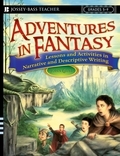
Adventures in fantasy: lessons and activities in narrative and descriptive writing, grades 5-9
Gust, John
Adventures in Fantasy offers an exciting approach to teaching narrative and descriptive writing that stimulates a student’s creativity and imagination. Filled with mini-lessons, reading projects, and hands-on writing activities, the book shows teachers step-by-step how to introduce students to the “magic” of creating a complete story in the fantasy/adventure genre. Before fleshing out their stories, however, students are asked to construct actual maps of their ‘fantasyland’ - and then to write a travelogue describing the setting in vivid detail. This initial fantasizing encourages students to be wildly inventive in creating the drama, ogres, villains, heroes and heroines featured in their story, and on the way they learn about the mythic journey. John Gust teaches fifth grade at a magnet school in the Los Angeles Unified School District and serves as adjunct lecturer/teacher trainer at various local universities. He has published numerous books on topics ranging from self-esteem enhancement, to character development, to systems thinking, to communication skills and multicultural education. Gust's first attempt at storytellingwas a personal narrative titled Round Peg, Square Hole: A Teacher Lives and Learns in Watts. Currently, Gust is writing a fantasy trilogy for young adults.For more information about John Gust, his writing workshops, and his other books, please visit www.johngust.org. INDICE: Introduction. Chapter 1: A Hero's Quest, a Writer's Journey. How to Use This Book. An Adventure in Fantasy. Genres of Fantasy. Epic, High, or Heroic Fantasy. Adventure Fantasy. Dark Fantasy. Fairy Tales. Magical Realism. Magic. The Hidden Force. Magic's Moral Component. Magical Words. Magical Tools.Practitioners of Magic. Chapter 2: Threading the Theme. Thinking About the Theme. Understanding Basic Themes. Theme Thread: What Do You Have to Say? Additional Theme Threads. Chapter 3: Forming the Fantasyland. The Fertile Crescent, from Book Two in The Taylor Thomas Trilogy: The Rock of Jerusalem, by Mr. Gust. Map-Making Assignment. Map-Making Prompt. Forming the Land. Character Domains. Determining the Terrain. Villages and Places. Embellishing the Map. Chapter4: Setting the Surroundings. Riding Horseback Through a Storm on the Grasslands, from Eragon, by Christopher Paolini. Landing in a Valley near the Great River, from The Chronicles of Narnia: The Magician's Nephew, by C. S. Lewis. Daybreak on a Mountain and in a Meadow at Noon, from The Temple of Light, by Mr. Gust. The Travelogue Assignment. Travelogue Prompt. Travelogue Guiding Outline. Travelogue Rubric. Travelogue Reader Response. Using Sensory Words. CreatingSensory Phrases. Setting the Mood. Traveling the Transition Trail. Keeping the Action Moving. Setting Description Practice. Chapter 5: Crafting the Characters. Contrasting Gandalf and Bilbo in The Hobbit, by J.R.R. Tolkien. Introducing Zanadar from The Temple of Light, by Mr. Gust. Crafting a Cast of Characters Assignment. Character Description Prompt. Character Description Guiding Outline. Character Description Rubric. Character Description Reader Response. Types of Characters. Fantasy Characters and Creatures. Character Illustrations. Naming Characters. Character Qualities. Character Description Graphic Organizer.Personality Traits. Character Actions: How Do They Move? Character History. Character Voices. Theme Thread: Contrasting Characters. Chapter 6: Plotting thePath. James Henry Trotter's Trip Across the Atlantic, in James and the Giant Peach, by Roald Dahl. Taylor Thomas's Trip Around the Fertile Crescent, in TheRock of Jerusalem, by Mr. Gust. Plot Line Assignment. Plot Line Prompt. Plot Line Rubric. Plot Line Listener Response. The Linear Path. Linear Plot Line Graphic Organizer. Mission in Motion: The Complication. The Circular Path. ThemeThread: Traveling Inward. Theme Thread: The Resolution. Chapter 7: Wording the Wonders. Before Beginning. Point of View. Transitions and Transitions of Time. Story Showing. Show, Don't Tell: What Did They Do? Can You Fantasize? ProveIt. Show It! Dynamic Dialogue. Speaker Tags. Tagging Your Speakers. Quotations and Indents. Say Do ... Do Say ... Say Do Say ... Talk and Feel ... Think and Talk. Figurative Language. Personifi cation. Similes. Be a Master of Metaphor. The Sounds of Words. How About a Little Alliteration? The Land of Assonance. Whack! Bang! Ping! Onomatopoeia. Chapter 8: Sketching the Scene. On Camazotz, in A Wrinkle in Time, by Madeleine L'Engle. In the Subterranean City Telos, in The Temple of Light, by Mr. Gust. Sketching the Scene Assignment. Get the Whiteout Out! Scene Sketch. Scene Summary. Scene Summary Rubric. Chapter 9: Starting the Story. Starting the Story Assignment. Chapter 10: Trimming the Tale.Writers' Workshop. Readers Respond. Conferencing and Connecting with Students. Revising. The Mechanics of Revision. Proofreading. Chapter 11: Booking the Boon. Booking the Boon Workshop. Bookmaking. Bibliography. Index.
- ISBN: 978-0-7879-9290-3
- Editorial: Jossey Bass
- Encuadernacion: Rústica
- Páginas: 272
- Fecha Publicación: 12/02/2010
- Nº Volúmenes: 1
- Idioma: Inglés
